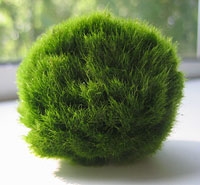
Popular lake balls under threat
Algae are not what immediately spring to mind when people think of threatened species. But even among algae there are species that have a difficult time, such as ‘Aegagropila linnaei’. In the magazine BioScience Christian Bödeker describes the worldwide decline of this species. He calls for the species to be protected.

Green soup
Many people only know algae as plants that thrive in purified water and turn it into green soup. But there are also species of algae that have a tough time. The decline of many species goes unnoticed because only few people are familiar with algae, and very few biologists carry out research on the species.
Football
Aegagropila linnaei has many different growth forms. The algae form filaments that attach to stones and shells or they can become knotted into mats that hang above the sea bed. But the most spectacular are spherical shapes that form on the bottom of lakes. The balls develop on sandy, sloping seabeds as a result of the movement of the water, in combination with specific characteristic shapes. The sturdy filaments with lateral branches that make up the algae easily become entangled with one another, and if these balls roll over the sea bed, they become rounded. 'The balls can be as big as a football,' says Bödeker. ‘But they grow very slowly, a maximum of one centimetre a year.'
Habitat
The distribution of Aegagropila is spread over a large area" Lake balls an be found in Japan, Iceland, Sweden, North-Eastern Germany, Ukraine, England, Ireland and several other North European countries as well as North America. They used to be found in the Netherlands, too, in the Naarden Lake and the Loosdrechtse Lakes (in North Holland), De Wieden (Overijssel) and Zwarte Broek (Friesland). But for the past 40 years there have been no more sightings. Bödeker is actively looking for lake balls in the old sites in Netherlands. 'I found no lake balls, but did come across another form, that had never been recorded in the Netherlands. 'Must have managed to miss it, somehow.' he says.
Water birds
But everywhere in itsdistribution area, Aegagropila is thin on the ground. Is it so demanding, then? 'It can do well in shallow water poor in nutrients or with an average food supply, but rich in calcium and non-acidic. All in all, it has no specific demands. But even in places that are in principle well-suited to the species, it is still rare.' Bödeker puts this down to its under-developed means of dispersal. Many other types of algae spread because their filaments or akinetes (a kind of spore) stick to the feathers of water birds and are carried from one lake to another. But the filaments of Aegagropila cannot survive if they are dried out, and it doesn't form akinetes. This leaves the alg few possibilities for reaching a new habitat.
Rare phenomenon
Aegagropila grows very slowly and so is a poor rival for other algae species. If it arrives in a new habitat, it has little chance of survival if there are other species already established there. This naturally rare phenomenon has declined even further in recent decades. Bödeker made an inventory of herbarium material, studied the literature and contacted nature protection bodies and water management companies. Worldwide, some 300 locations have been found, but in the past thirty years Aegagropila has only been found on 100 locations.
Aquarium trade
Bödeker believes that the decline may be the consequence of water becoming richer in nutrients. This would give rapid growing species an advantage, allowing them to crowd out Aegagropila. Moreover nutrient-rich water is cloudy and little light penetrates to the bottom. The aquarium trade is less of a concern: 'Retailers do take lake balls out of the water but as I understand it, they all come from one lake in the Ukraine. This means the threat is restricted to this particular lake.'
National symbol
Aegagropila linnaei is almost extinct in the Netherlands, and in other areas within its dispersal area, it is declining rapidly. Protective measures have to be taken in those places where it does occur, in Bödeker's opinion. ‘Algae are in general not a species that people feel warmly about, but lake balls do attract some attention and can act as a warning for less visible species. In Japan the popularity of lake balls has been the saviour of Aegagropila. It is a national symbol there and enjoys a high degree of protection.'
